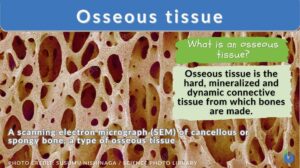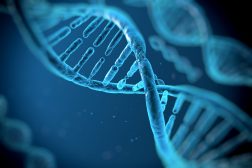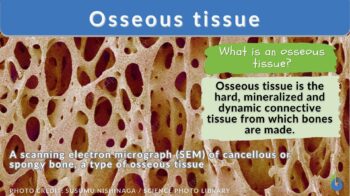
Osseous tissue
n., plural: osseous tissues
[ˈɒsɪəs ˈtɪʃu]
Definition: The major structural and supportive connective tissue from which bones are made.
Table of Contents
What Is Bone Or Osseous Tissue?
Osseous tissue is the structure providing, hard and mineralized connective tissues. Osseous tissue is also called bone tissue. Bone tissue forms the skeletal system structure of the body in most vertebrates.
Structurally, the matrix of the osseous tissue is honeycomb-like to provide rigidity to the structure. Bone is a dynamic tissue and its homeostasis is primarily maintained by the following bone cells, namely:
- Osteoblast– Cells that carry out bone formation
- Osteocytes– Cells that act as a mechanosensor and are also involved in bone remodeling
- Osteoclasts– cells that carry out bone resorption
Bone tissue is as metabolically active tissue composed of special bone cells. bone remodeling is a delicate balance and execution of the action between the above three cells i.e., osteoblasts, osteocytes, and osteoclast (Figure 1).
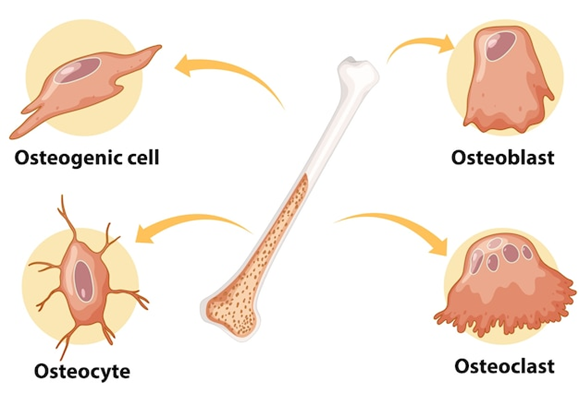
The matrix of the bone is mineralized and is made up of organic and inorganic components. The mineralized organic matrix component is collagenous fibers known as ossein whereas the bone mineral-containing salts form the inorganic component.
The newly formed organic matrix of bone is primarily made up of type I collagen fibers. The resistance to fracture and bone tensile strength in bones is due to the elasticity of the collagen fibers or the ossein present in the extracellular matrix of bone.
Hydroxyapatite is the mineral salt present in the bone. Hydroxyapatite is majorly calcium phosphate. The process of deposition and accumulation of mineral salts in the collagen fibers of the bone is known as calcification. Calcification of the collagen fibers results in the hardening of the bone tissue.
The mineralized tissue of bone consists of (Figure 2):
- Compact /cortical bone tissue – outer, hard layer
- Cancellous/spongy bone tissue – inner, spongy layer
Apart from that, bone tissue also contains, nerves and blood vessels.
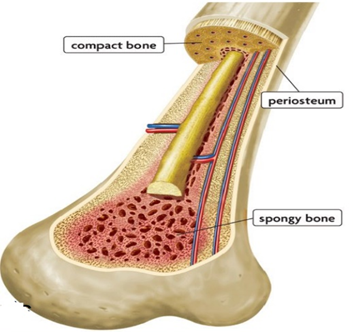
Watch this vid about osseous tissue:
Biology definition:
Osseous or bone tissue is the hard, mineralized, and dynamic connective tissue that provides the skeletal structure of the human body and other vertebrates. Homeostasis of the osseous tissue is maintained by osteoblasts, osteocytes, and osteoclast cells along with nerve, lymphatic, and blood supply. Hydroxyapatite is the mineral component of the bone tissue. Osseous tissues are of two major types: compact bone and spongy bone tissues.
Etymology: from Latin osseus, bony, equiv. to oss- (s. of os) bone + -eus..
Synonym: bone tissue
Bone Or Osseous Tissue: Structure
As we know, bone tissue is made up of an outer hard layer known as compact bone tissue, which is also called cortical bone tissue whereas the inner spongy layer forms the cancellous or spongy tissue.
Compact tissue or cortical tissue
The cortical tissue or the compact tissue of the bone forms 80% of the skeleton system and it provides a smooth and solid appearance to the bones. The compact tissue is dense and harder than the spongy tissue. Compact tissue forms almost 80% of the total bone mass.
The outer layer of the compact tissue is made up of dense connective tissue known as periosteum. Hence, the outermost layer of the bone is the periosteum. Further, compact tissue is made up of circular structures known as osteons. Each osteon contains osteoblasts and osteocytes in multiple layers.
A bunch of nerves, blood vessels, and lymphatic vessels pass through the center of each osteon, which is also known as the central canal of the osteon. The central canal that houses the blood vessels and nerves is referred to as the Haversian canal.
Each osteon has concentric lamellar layers or lamellae, that surround the central canal. The alignment of all the osteons in the compact tissue of the bone is in the same direction, along the stress lines thus imparting resistance to stress and breakage.
The blood vessels and nerves of each osteon connect with the central canals of other osteons and eventually connect with the periosteum through Volkmann’s canals which are present at the right angles (Figure 3).
Between the periosteum and osteons, circumferential, concentric lamellae surrounding the whole bone tissue are present.
The boundary between the cortical tissue and the spongy tissue is referred to as the endosteum. Thus inner surface is formed by the endosteum.
The cortical tissue or the compact tissue of the bone functions to:
- Providing support to the whole body,
- Protection of the organs,
- Provide the levers for movement,
- Storage and release of chemical elements like calcium
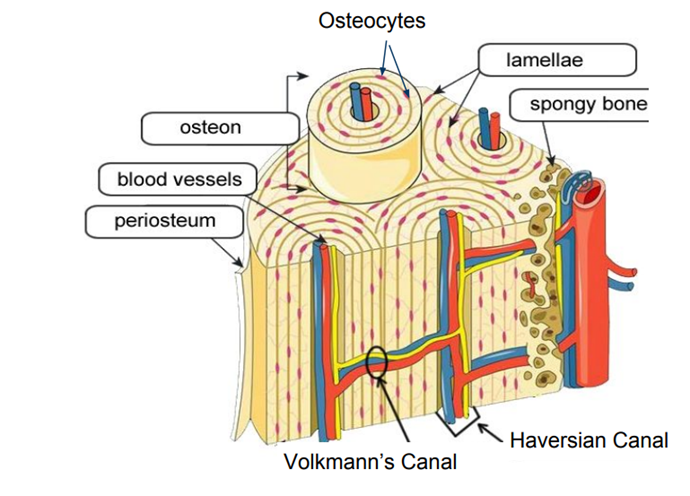
NOTE IT!
What is a periosteum?
Periosteum covers all the bones and bones surfaces except the attachment site of ligaments and tendons to the bone.
Spongy bone tissue or cancellous bone tissue
Spongy tissue is the porous structure present in the bone. The spongy tissue of the bone is made up of projections known as trabeculae, which provide a large surface area in this tissue.
Cancellous tissue is also referred to as spongy due to the network formed by the tiny projections or trabeculae. The trabeculae are aligned in the direction of stress distribution and can realign themselves in case the direction of stress changes.
The osteoblasts present near the endosteum form the irregular network of trabeculae (Figure 4). Spongy bone is also referred to as trabecular bone.
Spongy tissue is less dense as compared to compact tissue and has a higher volume to the surface area ratio as compared to cortical tissue. The spongy network tissue provides flexibility to the bone tissue. The large surface area provides a suitable area for easy exchange of calcium ions and metabolic activities.
Spongy tissue or cancellous tissue is highly vascular and often contains bone marrow. Bone marrow is found in the hollow spaces present between the trabeculae network or trabecular marrow.
Bone marrow is the site for hematopoiesis, wherein the production of red blood cells occurs. Trabeculae are the functional and anatomical unit of spongy tissue. Though the trabecular bone accounts for only 20% of the bone mass, it contributes to almost 10 times the surface area of the bone tissue.
This unique design of bone imparts its lightweight and at the same time hardness and strength.
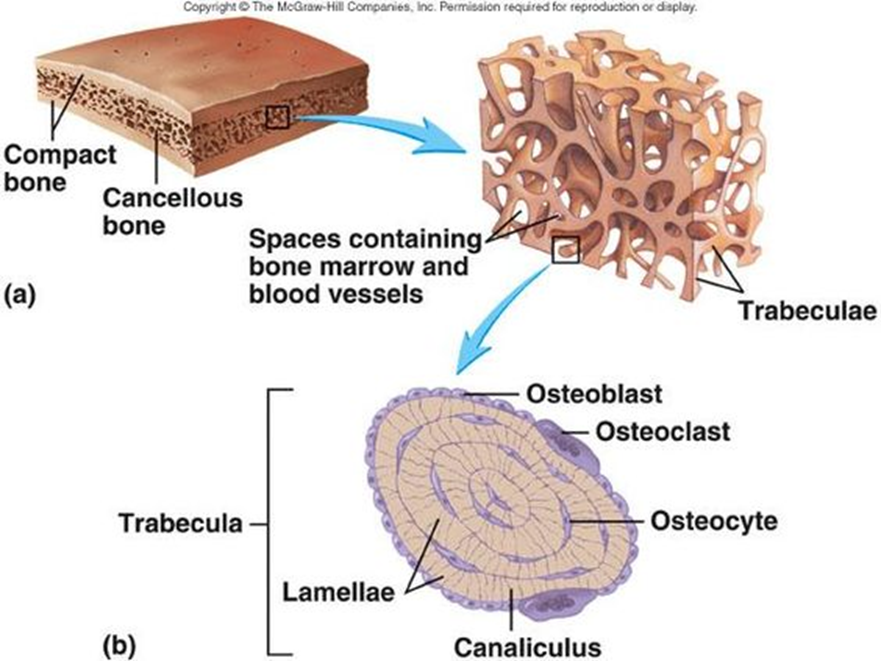
Bone marrow
The bones contain spongy tissue or the cancellous tissue contains myeloid tissue or bone marrow in the red bone marrow. Red bone marrow is the site of the production of blood cells (red blood cells and white blood cells).
NOTE IT!
The bone marrow of newborn vs. adult
In newborns, all the bone marrow in spongy tissue is completely red bone marrow or hematopoietic marrow. However, as the child ages, a part of the hematopoietic fraction decreases and is replaced by the fatty fraction or yellow fraction, which is referred to as marrow adipose tissue (MAT). In adults, the red bone marrow is only found in the ribs, femur, pelvic bones, and vertebrae.
Vascular supply
The osseous tissue receives 10% of the cardiac supply. Vascular supply makes entry through the endosteum and flows through the marrow and leaves as small vessels in the cortex. The blood oxygen tension in bones is ~6.6% as against 12% in the arterial blood and 5% in capillary and venous blood supply.
Cells
Bone is a dynamic and metabolically active tissue wherein the homeostasis of the osseous tissue is maintained by three types of specialized bone cells, namely, osteoblasts, osteocytes, and osteoclasts.
Osteoblasts
Osteoblasts are the cuboidal, mononucleate bone-forming cells that are found near the surface of the bone. Osteoblasts are responsible for bone formation, bone healing, and bone repair. Osteoblasts are also involved in bone regeneration during fractured bone healing. They constitute about 4 to 6% of the bone cells.
Osteoblasts originate from the mesenchymal stem cells. Characteristically, these cells are involved in protein synthesis and hence are rich in the Golgi apparatus and endoplasmic reticulum. The protein secreted is known as osteoid (majorly Type I collagen fibers), which eventually gets mineralized. These cells also secrete prostaglandins.
On maturation, osteoblasts move to discrete bone surfaces and become trapped in the bone during bone mineralization. The trapped osteoblasts then become osteocytes. The untrapped osteoblast cells remain on the surface of the bone and protect the underlying bone and eventually becoming bone lining cells.
Osteocytes
Osteocytes form the majority of the bone cells (~90-95%) and have a long life span of almost 25 years. Osteocytes possess dendritic morphology and are found inside lacunae present in the mineralized bone matrix. The body of the osteocytes is present inside the lacunae; however, its cytoplasmic processes form tiny channels, known as called canaliculi, which form the osteocyte lacunocanalicular system. Osteocytes communicate with osteoblasts as well as osteoclasts through gap junctions, which are connected to canaliculi.
Osteoclasts
Osteoclasts are differentiated multinucleated cells. Osteoclasts cells are involved in bone reabsorption. Osteoclasts are found on the bone surface in the Howship’s lacunae or resorption pits. Osteoclast cells have the phagocytic property as they originate from monocyte stem cells. Thus, bone is a dynamic tissue, which constantly undergoes remodeling by osteoblasts and osteoclast cells. Also, osteoclasts cells are involved in the homeostasis of calcium ions.
Frequently Asked Questions
What is osseous tissue made of?
Osseous tissue is made up of living cells, namely, osteocytes, osteoblasts, and osteoclast cells, of which osteocytes constitute the majority of the total bone tissue. Apart of from these cells, osseous tissue contains Type I collagen fiber and minerals like calcium phosphate.
Where is osseous found in the body?
All the bones of the body have osseous tissue. Depending upon the type of bone, osseous tissue can have major tissue as compact bone (mostly in long bones like the femur) and spongy bone (also called trabecular bone is mostly seen in flat bones).
What is the main function of bone tissue?
Bone exerts important functions in the body:
- Provide locomotion
- Provide support and structure to the body
- Protection of soft tissues, internal tissues, and organs
- Storage of calcium and phosphate storage
- Houses bone marrow which is responsible for blood cell formation
NOTE IT!
What is a periosteum?
Periosteum covers all the bones and bones surfaces except the attachment site of ligaments and tendons to the bone.
Take the Osseous Tissue – Biology Quiz!
References
- · Ansari M. (2019). Bone tissue regeneration: biology, strategies and interface studies. Progress in biomaterials, 8(4), 223–237. https://doi.org/10.1007/s40204-019-00125-z
- · Clarke B. (2008). Normal bone anatomy and physiology. Clinical Journal of the American Society of Nephrology: CJASN, 3 Suppl 3(Suppl 3), S131–S139. https://doi.org/10.2215/CJN.04151206
- · Florencio-Silva, R., Sasso, G. R., Sasso-Cerri, E., Simões, M. J., & Cerri, P. S. (2015). Biology of Bone Tissue: Structure, Function, and Factors That Influence Bone Cells. BioMed research international, 2015, 421746. https://doi.org/10.1155/2015/421746
- · Mohamed A. M. (2008). An overview of bone cells and their regulating factors of differentiation. The Malaysian journal of medical sciences : MJMS, 15(1), 4–12.
©BiologyOnline.com. Content provided and moderated by Biology Online Editors.

